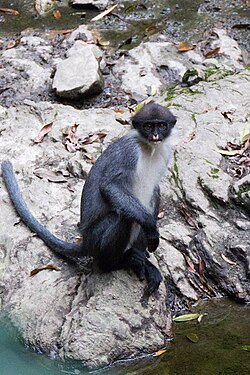Conservation status
Miller's langur is listed as endangered by the IUCN due primarily to habitat loss, fragmentation and hunting. [1] It is one of the rarest primates in Borneo. With little information available, it was thought to be extinct several times. [8] In 2012, a team of international scientists rediscovered it in Wehea Forest in East Kalimantan, Borneo, disproving its extinction. [8] [9] Wehea Forest is outside Miller's langur's previously known range, which was primarily Kutai National Park to the south of Wehea. [9] [7] The scientists used mineral licks and cameras to show that the species still exists, and had difficulty identifying it from the photos since so few photos previously existed. [9] Limited to a geographical range from the central coast of East Kalimantan to the Kutai National Park, the species is highly regarded as an endemic and extremely vulnerable primate. Experts speculate it becoming extinct in the very near future, due to multiple factors such as deforestation and overhunting for its bezoar stones and as a food source. [10] The bezoar stones, which are smooth, hard mineral deposits found in the digestive tracts of some animals, are used as good luck charms, and also for its alleged ability to neutralize some poisons, but only occur in a minority of the monkeys. [7] Although Miller's langur is protected under Indonesian law, the legal protections may be ineffective because it is listed under a defunct scientific name, P. aygula. [4]
In October of 2019, Forrest Galante led an expedition and recorded the first video evidence of a Miller's langur in the 21st century. [11]
This page is based on this
Wikipedia article Text is available under the
CC BY-SA 4.0 license; additional terms may apply.
Images, videos and audio are available under their respective licenses.


